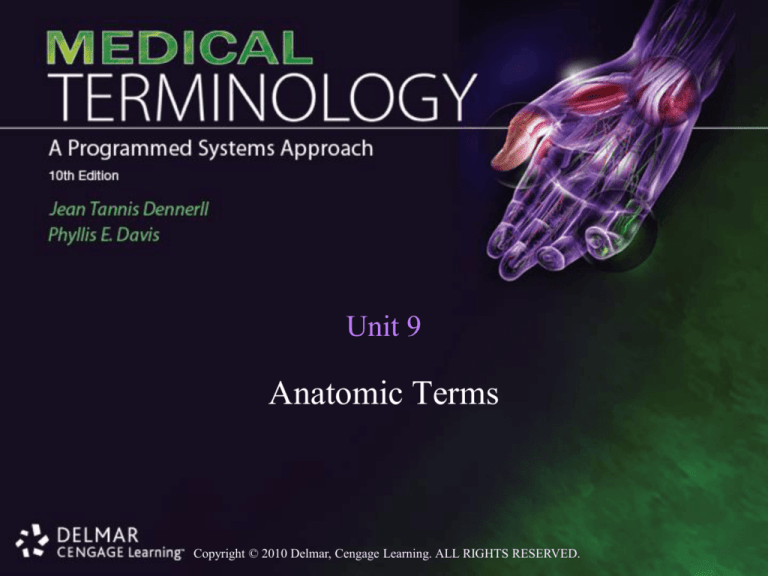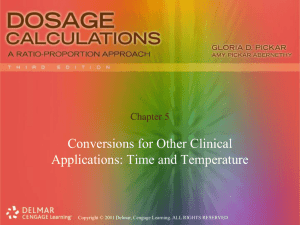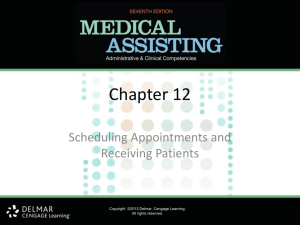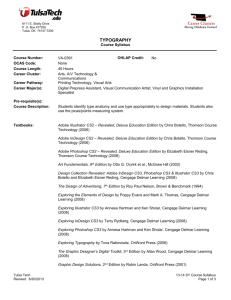
Unit 9
Anatomic Terms
Copyright © 2010 Delmar, Cengage Learning. ALL RIGHTS RESERVED.
Anatomy
• ana/tomy = study of naming body structures
• Origin
– Greek
– anatome = cutting apart
• Galen
– Greek anatomist who dissected corpses to identify and
name body parts using both Greek and Latin terms
Copyright © 2010 Delmar, Cengage Learning. ALL RIGHTS RESERVED.
Summary of Directional Terms
Used with the Body
Word
Combining Form
Meaning
dorsal
dors/o
near or on back
ventral
ventr/
near or on belly side
anterior
anter/o
toward front or in front of
posterior
poster/o
following or located behind
cephalic
cephal/o
upward or toward head
Copyright © 2010 Delmar, Cengage Learning. ALL RIGHTS RESERVED.
Summary of Directional Terms
Used with the Body
Word
Combining Form
Meaning
caudal or caud/o
caudad
downward or toward tail
medial
lateral
medi/o
later/o
toward midline
toward side away from midline
superior
super/o
above
inferior
infer/o
below
Copyright © 2010 Delmar, Cengage Learning. ALL RIGHTS RESERVED.
Summary of Directional Terms
Used with the Body
Word
Combining Form
proximal proxim/o
distal
dist/o
sagittal
sagitt/o
coronal
coron/o
Meaning
near point of origin
away from point of origin
vertical anteroposterior
direction or plane dividing into
left and right
resembling crown or encircling
Copyright © 2010 Delmar, Cengage Learning. ALL RIGHTS RESERVED.
Terms with anter/o
• anter/o/later/al = front and side
• anter/o/medi/al = front and middle
• anter/o/super/ior = front and top
Copyright © 2010 Delmar, Cengage Learning. ALL RIGHTS RESERVED.
Terms with poster/o
•
•
•
•
poster/o/later/al = back and side
poster/o/extern/al = back and outside
poster/o/intern/al = back and inside
anter/o/poster/ior = pertaining to front and
back
– From front to back
Copyright © 2010 Delmar, Cengage Learning. ALL RIGHTS RESERVED.
Terms with ventr/o and dors/o
• ventr/o/dors/al = from front to back
• dors/o/cephal/ad = toward back of head
– -ad = suffix meaning toward
• ventr/ad and anter/ior = toward front
Copyright © 2010 Delmar, Cengage Learning. ALL RIGHTS RESERVED.
Proximal
• proxim/al = closer to designated point
– E.g., fracture in upper part of femur closest to hip is
proximal to end of femur
– E.g., bone in part of finger (phalanx) closest to palm is
proximal phalanx
Copyright © 2010 Delmar, Cengage Learning. ALL RIGHTS RESERVED.
Distal
• dist/al = farther from designated point
– E.g., fracture in lower part of femur away from hip is distal
to end of femur
– E.g., bone in tip of finger (phalanx) farther from origin of
finger is distal phalanx
Copyright © 2010 Delmar, Cengage Learning. ALL RIGHTS RESERVED.
Indicating Areas and Directions
•
•
•
•
medi/o/later/al = middle and side
super/o/later/al = above and to side
cephal/ad = toward head
caud/ad = toward tail
– Lower spine
• cephal/o/caud/al = head to tail
Copyright © 2010 Delmar, Cengage Learning. ALL RIGHTS RESERVED.
Planes of the Body
• Dividing body into slices or planes
– Method of studying anatomy and diagnosing
– Used in tomography and sonography
• sagitt/al = cut made at midline to divide body
into equal right and left halves
• mid/sagitt/al plane = plane resulting from cut
Copyright © 2010 Delmar, Cengage Learning. ALL RIGHTS RESERVED.
Animation
Click Here to Play Body Planes Animation
Copyright © 2010 Delmar, Cengage Learning. ALL RIGHTS RESERVED.
Axilla
• Armpit
• axill/ary = pertaining to region of armpit
• axill/ary temperature = body temperature
measured under arm
– Measures 1° Fahrenheit lower than oral temperature
Copyright © 2010 Delmar, Cengage Learning. ALL RIGHTS RESERVED.
Axilla
• mid/axill/ary = fifth intercostal space in line
with middle of armpit
– Location of electrocardiography (EKG) chest electrode
Copyright © 2010 Delmar, Cengage Learning. ALL RIGHTS RESERVED.
Coronal
• coron/al = crown or encircling
• coron/al suture line = line where bones join at
crown of skull
• coron/a dentis = crown of tooth
• coron/ary arteries = arteries that encircle and
supply heart with blood
Copyright © 2010 Delmar, Cengage Learning. ALL RIGHTS RESERVED.
Umbilicus
• Naval
– Belly button
• omphal/o = combining form
– Origins:
• umbilicus
– Latin
• omphalos
– Greek
Copyright © 2010 Delmar, Cengage Learning. ALL RIGHTS RESERVED.
Umbilical Conditions and Procedures
•
•
•
•
•
omphal/itis = inflammation of umbilicus
omphal/o/rrhagia = hemorrhage of umbilicus
omphal/o/rrhea = discharge from umbilicus
omphal/o/rrhexis = rupture of umbilicus
omphal/o/cele and umbilic/o/cele = herniation
of umbilicus
• omphal/ectomy = excision of umbilicus
Copyright © 2010 Delmar, Cengage Learning. ALL RIGHTS RESERVED.
Signs and Symptoms
• Sign
– Objective, observable information about patient
– E.g., skin color changes, lab tests, measurements
• Symptom
– Subjective information reported by patient about feelings
and experiences
– E.g., pain, nausea, tiredness
Copyright © 2010 Delmar, Cengage Learning. ALL RIGHTS RESERVED.
Knowledge
• gnosia and gnosis = knowledge
– Greek
• pro/gnos/is = foreknowledge
– Predicting outcome of disease
– pro- = prefix meaning before or in front of
• E.g., pro/cephal/ic = in front of head
Copyright © 2010 Delmar, Cengage Learning. ALL RIGHTS RESERVED.
Terms with dia• dia/gnos/is = knowing through
– Identifying disease through signs and symptoms
• dia- = prefix meaning through or throughout
– dia/rrhea = watery stool flowing through
– dia/scope = instrument through which skin examined
Copyright © 2010 Delmar, Cengage Learning. ALL RIGHTS RESERVED.
Dialysis
• dia/lysis = process of destroying waste products
in blood by diffusion through membrane
• Treatment for patients with kidney failure
• Two types:
– Peritoneal
– Hemodialysis
Copyright © 2010 Delmar, Cengage Learning. ALL RIGHTS RESERVED.
Terms with aer/o
• aer/o = used in words to mean air
• Examples:
–
–
–
–
aer/ial = pertaining to air
aer/o/phobia = abnormal fear of air
aer/o/therapy = treatment with air
aer/o/cele = herniation containing air
Copyright © 2010 Delmar, Cengage Learning. ALL RIGHTS RESERVED.
Terms with aer/o
• Examples:
– aer/o/bic = needing air (oxygen) to live
• Aerobic bacteria need air to live
• One type causes pneumonia
Copyright © 2010 Delmar, Cengage Learning. ALL RIGHTS RESERVED.
Terms with aer/o
• Examples:
– an/aer/o/bic = existing without air (oxygen)
• Anaerobic bacteria do not need air to live
• E.g., Tetanus bacillus
– Bacteria that causes lockjaw
• One type causes botulism
– Serious type of food poisoning
Copyright © 2010 Delmar, Cengage Learning. ALL RIGHTS RESERVED.
Terms with bios
• bios = life
– Greek
• Examples:
– bi/o/ology = science and study of living things
– bi/o/logist = one who studies living things
– bi/o/genesis = formation of living things
Copyright © 2010 Delmar, Cengage Learning. ALL RIGHTS RESERVED.
Terms with bios
• Examples:
– bi/o/ethics = topics that deal with decisions about life and
medical treatments that concern right and wrong
– bi/o/chemistry = study of chemical changes in living
things
– bi/o/psy = excision of living tissue for examination
Copyright © 2010 Delmar, Cengage Learning. ALL RIGHTS RESERVED.
Terms with chrom/o
• chrom/o = combining form for color
• Origin
– Greek
– chroma = color
Copyright © 2010 Delmar, Cengage Learning. ALL RIGHTS RESERVED.
Terms with chrom/o
• Examples:
–
–
–
–
–
chrom/o/cyte = any colored cell
chrom/o/blast = embryonic pigment cell
chrom/o/genesis = formation of pigment
chrom/o/lysis = destruction of color in cell
chrom/o/meter = instrument for measuring amount of
color in substance
Copyright © 2010 Delmar, Cengage Learning. ALL RIGHTS RESERVED.
Staining Cells
• chrom/o/philic = attracts color and stains easily
– phil = word root meaning attracted to
– E.g., some leukocytes
• chrom/o/phobic = will not stain
– Gram-negative bacteria will not attract color from Gram stain
• a/chrom/o/philic = something that does not
stain easily
Copyright © 2010 Delmar, Cengage Learning. ALL RIGHTS RESERVED.
Terms with dys- and eu• dys- = difficult, painful, abnormal, or bad
• eu- = easy
• Examples:
– dys/enter/y = infections of small intestine
– dys/men/o/rrhea = difficult or painful menstrual flow
Copyright © 2010 Delmar, Cengage Learning. ALL RIGHTS RESERVED.
Terms with dys- and euDigestion:
dys/pepsia
dys/peptic
eu/pepsia
eu/peptic
Breathing:
dys/pnea
eu/penia
Movement:
dys/kinesi/a
eu/kinesi/a
Copyright © 2010 Delmar, Cengage Learning. ALL RIGHTS RESERVED.
Terms with dys- and euSense or Sensation:
dys/esthesi/a eu/esthesi/a
Emotional state:
dys/phor/ia
eu/phor/ia
Labor (childbirth):
dys/tocia
eu/tocia
Copyright © 2010 Delmar, Cengage Learning. ALL RIGHTS RESERVED.
Euthanasia
• eu/than/asia = easy or peaceful death
• Origin
– Greek
– thanatos = death
• Subject of many ethical medical questions
Copyright © 2010 Delmar, Cengage Learning. ALL RIGHTS RESERVED.
Eugenics
• eu/gen/ics = good development
• Genetic engineering
– Alteration of genetic material to produce desirable changes
in traits
Copyright © 2010 Delmar, Cengage Learning. ALL RIGHTS RESERVED.
Eugenics
• Eugenic sterilization
– Selective sterilization of individuals that society believes
have undesirable traits
– E.g., severely mentally impaired adults
• Controversial topic of bioethics
Copyright © 2010 Delmar, Cengage Learning. ALL RIGHTS RESERVED.
Menstruation
• Menses
• Menarche
– Female’s first menstrual period
• Origin
– Greek
– men = month
– arche = beginning
Copyright © 2010 Delmar, Cengage Learning. ALL RIGHTS RESERVED.
Menstruation
• men/o/rrhagia = excessive menstrual
hemorrhage
• men/o/pause = permanent cessation of
menstruation
• a/men/o/rrhea = absence of menstrual flow
• men/o/stasis = stopping menstrual flow
Copyright © 2010 Delmar, Cengage Learning. ALL RIGHTS RESERVED.
Animation
Click Here to Play Ovulation Animation
Copyright © 2010 Delmar, Cengage Learning. ALL RIGHTS RESERVED.
Suffix: -stasis
• -stasis = act or condition of stopping or
controlling
• Examples:
– phleb/o/statis and ven/o/stasis = control of blood flow in
veins
– arteri/o/stasis = control of flow in arteries
– lymph/o/stasis = control of lymph flow
– hem/o/stat = instrument used to control blood flow
Copyright © 2010 Delmar, Cengage Learning. ALL RIGHTS RESERVED.
Syphilis
• Sexually transmitted disease
• syphil/o = combining form
• Examples:
– syphil/o/pathy = any syphilitic disease
– syphil/o/phobia = fear of contracting syphilis
Copyright © 2010 Delmar, Cengage Learning. ALL RIGHTS RESERVED.
Syphilis
• Examples:
– syphil/o/psych/osis = mental condition caused by syphilis
– syphil/oma = syphilitic tumor
– syphil/o/therapy = therapy for syphilis
Copyright © 2010 Delmar, Cengage Learning. ALL RIGHTS RESERVED.
Terms with pseud/o
• pseudo- = false
• Examples:
– pseud/o/science = false science
– pseud/o/mania = psychosis when patients have false or
pretended mental disorder
– pseud/o/esthesi/a = false or imaginary sensation
Copyright © 2010 Delmar, Cengage Learning. ALL RIGHTS RESERVED.
Terms with pseud/o
• Examples:
– pseud/o/paralysis = false paralysis
• Not due to nerve damage
– pseud/o/cesis and pseud/o/pregnancy = false pregnancy
– pseud/o/cyst = false cyst
– pseud/o/edema = false puffiness
• Not due to fluid accumulation
Copyright © 2010 Delmar, Cengage Learning. ALL RIGHTS RESERVED.
Terms with pseud/o
• Examples:
– pseud/o/hyper/trophy = false growth of organ or part due
to another type of tissue
– pseud/o/neur/oma = false nerve tumor
– pseud/o/tubercul/osis = false tuberculosis
Copyright © 2010 Delmar, Cengage Learning. ALL RIGHTS RESERVED.
Viscera
•
•
•
•
Internal organs
viscus = singular form
viscer/o = combining form
Examples:
– viscer/al = pertaining to internal organs
– viscer/o/genic = development of organs
Copyright © 2010 Delmar, Cengage Learning. ALL RIGHTS RESERVED.
Viscera
• Examples:
– viscer/o/motor = producing or related to movements of
viscera
– viscer/ad = toward viscera
– viscer/o/skeletal = pertaining to organs and skeleton
– viscer/o/pariet/al = pertaining to viscera and abdominal
wall
Copyright © 2010 Delmar, Cengage Learning. ALL RIGHTS RESERVED.
Viscera
• Examples:
–
–
–
–
viscer/o/pleur/al = relating to pleural and thoracic viscera
viscer/o/sensor/y = sensory function of organs
viscer/o/ptosis = prolapse of organs
viscer/algia = pain in organs
Copyright © 2010 Delmar, Cengage Learning. ALL RIGHTS RESERVED.
Membranes
• viscer/al periton/eum = membrane that lines
organs of abdominal cavity
• viscer/al pleural membrane = membrane that
lines lungs
Copyright © 2010 Delmar, Cengage Learning. ALL RIGHTS RESERVED.
Terms with pariet/o
• pariet/o = combining form for wall
• Examples:
– pariet/al pleura = membrane on chest cavity wall
– pariet/al peritoneum = membrane on abdominal cavity
wall
Copyright © 2010 Delmar, Cengage Learning. ALL RIGHTS RESERVED.
Ventral Cavity Membranes
Copyright © 2010 Delmar, Cengage Learning. ALL RIGHTS RESERVED.
Prefixes of Location
Prefix
Meaning
ecto-
outer or outside
endo-
inner or inside
meso-
middle
retro-
backward or behind
para-
near
Copyright © 2010 Delmar, Cengage Learning. ALL RIGHTS RESERVED.
Prefixes: ecto- and exo• ecto- = outside
– Latin
• exo- = outside
– Greek
• ecto/gen/ous and exo/gen/ous = something
produced outside organism
Copyright © 2010 Delmar, Cengage Learning. ALL RIGHTS RESERVED.
Terms with ecto• Examples:
– ecto/cyt/ic = pertaining to outside cell
– ecto/plasm = protoplasm that forms outer membrane of
cell
– ecto/p/ic = pertaining to outside of
Copyright © 2010 Delmar, Cengage Learning. ALL RIGHTS RESERVED.
Ectopic Pregnancy
• ecto/p/ic pregnancy = pregnancy that occurs
outside of uterus
– Usually occurs in fallopian tube
• Can cause rupture of tube
– May occur in abdominal wall
Copyright © 2010 Delmar, Cengage Learning. ALL RIGHTS RESERVED.
Prefix: endo• endo- = inside
• Examples:
– endo/plasm = plasm inside cell
• Also known as cyto/plasm
– endo/crani/al = within cranium
– endo/chondr/al = within cartilage
Copyright © 2010 Delmar, Cengage Learning. ALL RIGHTS RESERVED.
Prefix: endo• Examples:
– endo/cardi/al and endo/cardi/ac = pertaining to lining of
heart
– endo/col/itis = inflammation of lining of colon
– endo/scope = instrument used to looks into hollow organ
or cavity
– endo/scopy = process of viewing organ through scope
Copyright © 2010 Delmar, Cengage Learning. ALL RIGHTS RESERVED.
Types of Endoscopies
• gastr/o/scopy = process of viewing stomach
through scope
• esophag/o/gastr/o/duoden/o/scopy (EGD) =
viewing esophagus, stomach, and duodenum
with scope
Copyright © 2010 Delmar, Cengage Learning. ALL RIGHTS RESERVED.
Word-Building
Copyright © 2010 Delmar, Cengage Learning. ALL RIGHTS RESERVED.
Prefix: meso• meso- = middle
• Examples:
– mes/enter/y = peritoneum attaching intestine to abdominal
wall
• Middle intestine
– meso/colon = peritoneum attaching large intestine to
abdominal wall
– meso/dont/ic = pertaining to middle-sized teeth
Copyright © 2010 Delmar, Cengage Learning. ALL RIGHTS RESERVED.
Tissue Layers
• blast/o/derm = embryonic disk of cells that
gives rise to three main layers of tissue
• ecto/derm = forms skin and nervous system
• endo/derm = inner germ layer
– Forms organs inside body
• meso/derm = middle germ layer between
ectoderm and endoderm
Copyright © 2010 Delmar, Cengage Learning. ALL RIGHTS RESERVED.
Prefix: retro• retro- = behind
• Examples:
– retro/colic = behind colon
– retro/mammary = behind breast
• Mammary glands
– retro/stern/al = behind sternum
Copyright © 2010 Delmar, Cengage Learning. ALL RIGHTS RESERVED.
Prefix: retro• Examples:
– retro/periton/eum = space behind peritoneum
– retro/periton/itis = inflammation in this space
– retro/vers/ion = turning backward
• ante/vers/ion = turning forward
– retro/flex/ion = bending backward
• ante/flex/ion = bending forward
Copyright © 2010 Delmar, Cengage Learning. ALL RIGHTS RESERVED.
Prefix: para• para- = near, beside, or around
• Examples:
–
–
–
–
–
–
para/centr/al = near center or around center
para/hepat/itis = near liver
para/nephr/itis = near kidney
para/appendic/itis = inflammation around appendix
para/cyst/itis = inflammation around or near bladder
para/colp/itis = inflammation of tissues around vagina
Copyright © 2010 Delmar, Cengage Learning. ALL RIGHTS RESERVED.








